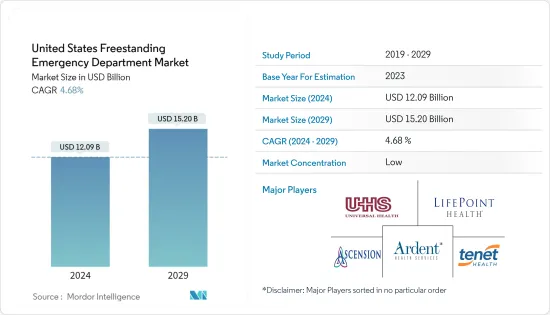PUBLISHER: Mordor Intelligence | PRODUCT CODE: 1433913

PUBLISHER: Mordor Intelligence | PRODUCT CODE: 1433913
United States Freestanding Emergency Department - Market Share Analysis, Industry Trends & Statistics, Growth Forecasts (2024 - 2029)
The United States Freestanding Emergency Department Market size is estimated at USD 12.09 billion in 2024, and is expected to reach USD 15.20 billion by 2029, growing at a CAGR of 4.68% during the forecast period (2024-2029).

Health care institutions and government organizations all throughout the world largely depended on emergency freestanding department systems to respond to COVID-19. In April 2020, in order to handle any rise in patients on Medicare and Medicaid, the Centers for Medicare and Medicaid Services (CMS) released crucial guidance authorizing licensed, independent freestanding emergency departments (IFEDs) in Colorado, Delaware, Rhode Island, and Texas to temporarily provide care. Additionally, in December 2021, the COVID-19 public health emergency: terminated the streamlined process for ambulatory surgical centers and independent freestanding emergency departments to temporarily enroll as hospitals. To address the pandemic needs, the United States government decided to enroll the existing emergency department in the COVID-19 emergency department. As a result, the freestanding emergency department market in the United States suffered during COVID-19.
Certain factors that have been driving the market growth include a growing number of consumer-driven health plans and federal funding and the rising preference for convenience care. For instance, in June 2022, the United States Department of Health and Human Services (HHS) has announced approval of Colorado's Section 1332 State Innovation Waiver amendment request. in 2023 ,approximately 10,000 Americans will have access to more affordable coverage due to the implementation of the "Colorado Option," a state-specific health coverage scheme that will improve health coverage enrollment, reduce health care expenditures, and cut health care prices. Thus, growing consumer driven plan in United States, drive the growth of the market studied.
According to the study titled "What is a Freestanding Emergency Department? Definitions Differ Across Major United States Data Sources" published in the West Journal of emergency Medicine in May 2021, the number of freestanding emergency departments (FSEDs) has been growing rapidly in the United States. Proponents of FSEDs cite potential benefits of FSEDs, including lower waiting time and reduced travel distance for needed emergency care. Thus, growing number of freestanding emergency departments (FSEDs) expected to boost the market growth over the forecast period.
However, previous studies on emergency care access and expenditure indicate that the higher access may lead to higher utilization of health care services, which may lead to an increase in overall health care costs.
United States Freestanding Emergency Department Market Trends
Hospital is Expected to Hold Significant Market Share in the Ownership Segment
Hospital-based freestanding emergency departments are a new and evolving care delivery model. These departments, which are common across the country, may be owned and run by a hospital (under the name "hospital outpatient department," or HOPD). The ability to provide top-notch emergency treatment at even greater levels of customer service is one of the reasons why many hospitals construct freestanding emergency departments. Factors such as hospital emergency department overcrowding, an increase in the number of trauma cases, and an increase in the prevalence of stroke and other neurological illnesses that require prompt attention are all contributing to the increase.
Additionally, the need for hospital FSED in the nation is being driven by the rise in accident-related injuries as well as the development of diseases like epilepsy and stroke, and chest discomfort, both of which necessitate prompt medical attention. For instance, according to the article published in the American Heart Association Journal in May 2021, by Dawn O. Kleindorfer, in the United States, 795 000 people have a stroke each year, with 87% (690 000) being ischemic and 185 000 being recurrent. Each year, over 240,000 people suffer from a transient ischemic attack (TIA).
According to the study titled "Emergency Department Crowding: The Canary in the Health Care System" published in the Innovation in Care Delivery in September 2021, Prior to the Covid-19 outbreak, ED visits had increased by more than 60% since 1997, to over 146 million. Thus, such instances is expected to increased in freestanding department in hospital facility thereby boost the segment growth.
Thus, all aforementioned factors expected to boost the segment growth over the forecast period.
United States Freestanding Emergency Department Industry Overview
The United States freestanding emergency department market is highly competitive and consists of a number of major players. Companies, like Adeptus Health Inc., Advis, Ascension Health, EMERUS, Lifepoint Health Inc., Tenet Healthcare Corporation, and Universal Health Services Inc., among others, hold a substantial market share in the United States freestanding emergency department market.
Additional Benefits:
- The market estimate (ME) sheet in Excel format
- 3 months of analyst support
TABLE OF CONTENTS
1 INTRODUCTION
- 1.1 Study Assumptions and Market Definition
- 1.2 Scope of the Study
2 RESEARCH METHODOLOGY
3 EXECUTIVE SUMMARY
4 MARKET DYNAMICS
- 4.1 Market Overview
- 4.2 Market Drivers
- 4.2.1 Growing Number of Consumer-driven Health Plans and Federal Funding
- 4.2.2 Rising Preference for Convenience Care
- 4.3 Market Restraints
- 4.3.1 High Overall Expenditure
- 4.4 Porter's Five Forces Analysis
- 4.4.1 Threat of New Entrants
- 4.4.2 Bargaining Power of Buyers/Consumers
- 4.4.3 Bargaining Power of Suppliers
- 4.4.4 Threat of Substitute Products
- 4.4.5 Intensity of Competitive Rivalry
5 MARKET SEGMENTATION (Market Size by Value - USD Million)
- 5.1 By Ownership Type
- 5.1.1 Hospital Affiliated
- 5.1.2 Independent
- 5.2 By Service
- 5.2.1 Laboratory Service
- 5.2.2 Imaging Service
- 5.2.3 Emergency Care and Other Services
6 COMPETITIVE LANDSCAPE
- 6.1 Company Profiles
- 6.1.1 Adeptus Health Inc.
- 6.1.2 Ascension Health
- 6.1.3 EMERUS
- 6.1.4 HCA Healthcare Inc.
- 6.1.5 Physicians Premier
- 6.1.6 Tenet Healthcare Corporation
- 6.1.7 Universal Health Services Inc.
- 6.1.8 Lifepoint Health, Inc.
- 6.1.9 Ardent Health Services
7 MARKET OPPORTUNITIES AND FUTURE TRENDS




